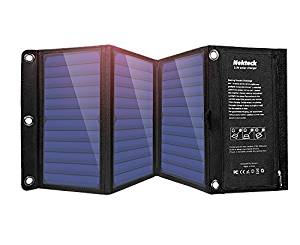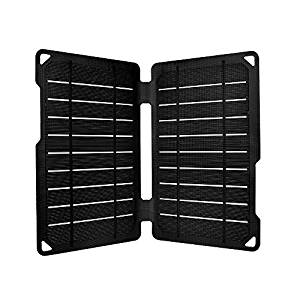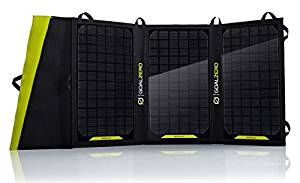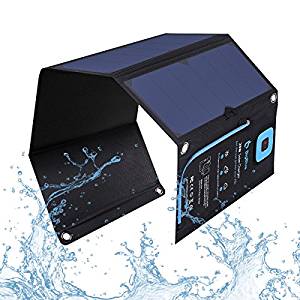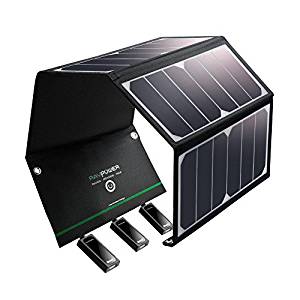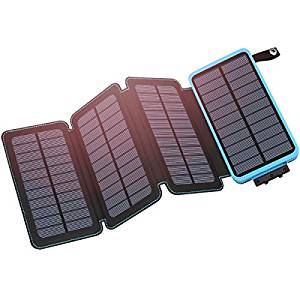Best Solar Powered Phone Charger
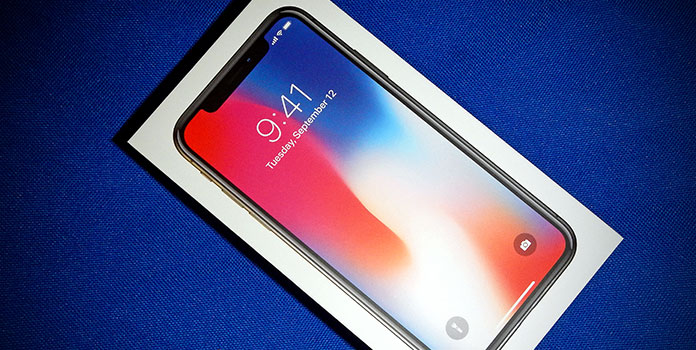
Solar powered phone chargers have come a long way in the last couple of years! Find the Best Solar Phone Charger for 2018!
Just two years ago the choices for solar phone chargers were quite underwhelming. Your only options were expensive, small chargers. Today, though they’ve dropped drastically in price, and increased in size. In fact, updating this ‘best of’ list of solar powered phone chargers for the current year, we’ve actually replaced every single product from the previous list!
Like it or not, our modern life requires a lot of devices: phones, tablets, cameras, smartwatches, laptops, GPS’s. Smartphones are ubiquitous across the globe and increasingly out in the wild–while backpacking, camping, or just lounging in the woods there’s an equal number of uses, which range from the frivolous to serious backcountry GPS apps or emergency signals.
This is great if you’re only out for a day or two, but more than that and your battery-powered devices can leave you hanging, running into issues if you don’t have any other emergency signal. Luckily, a new niche market has popped up around our need to be constantly charged, even in the wilderness.
These solar panels are rugged and built for the outdoors or for a disaster preparedness kit. They are packable, foldable, and covered in tough fabric to keep them safe. They’re easy to use, as you can just clip them onto your backpack as you hike or throw it over a sunny rock, plug your phone in, and watch that lightning bolt appear!
Best Solar Phone Chargers
To help you choose which solar charger to buy, we’ve done the heavy lifting by comparing popular, well-reviewed solar chargers from six different companies. We limited our products to those only available on Amazon, as it is the largest online marketplace in the world. We look at energy output, size and weight, reviews and any extra doodads that make life just a little bit better.
Best Solar Powered Phone Charger Overall: NekTech 21W Charger
Pros: Good price, great reviews
Cons: Poor ‘recovery’ from fleeting shade could be an issue
Our top pick for the best overall solar charger for 2018 goes to the NekTech 21 Watt Solar Charger. It’s well-priced and customers report it functions well and is quite durable.
At 21 watts, this product can charge up to 2 of your devices at a time. Tucked into the zippered pouch are two USB ports, each rated 5V/2A (what you need to charge the average smartphone or tablet). However, with a max production of 3 amps, you can’t charge at 2 amps for each port at the same time. The solar panel simply isn’t big enough for that.
Instead, the charger intelligently decides how to divvy up the solar power between the two ports for the speediest charging for your different devices. For example, it’ll send 2 amps to your tablet, and 1 amp to your smartphone.
Like most of the solar chargers below, NekTech covers the solar panels in a heavy, rugged canvas to protect the electric components inside. At 18 ounces, this charger weighs around the same as similarly-sized products on our list and is small enough to throw in a backpack or picnic bag.
It’s also dust and water resistant, so you can take it to the beach without too much worry. It comes with a zippered pocket for your devices both so you don’t lose them while charging and to keep them out of the dirt.
The NekTech charger enjoys hundreds of reviews from happy customers. Users report that the product is extremely durable and performs well when placed in full sun. However, some users noted they had issues with the solar charger recovering after brief cloud cover, a common challenge with these chargers. They reported that once the charging amperage drops, it won’t jump back up, even when the sun comes out again.
Users found that simply unplugging and plugging the device back in ‘jolts’ the charger into working again, but others found it easier to charge up a small battery pack and charge devices from that instead. Again, this is a fairly common issue for this kind of product and we didn’t see too much negative feedback for the Nektech on this issue.
Bottom Line: A quality product at a good cost. Can’t go wrong, especially considering it’s one of the cheapest options out there!
Best Small Solar Phone Charger: Renogy E.Flex Ultra-Thin 10W
Pros: Cheapest option on our list, extremely thin and light, auto-optimizes charging post-shading
Cons: Only 1 charge port, only comes in 5 and 10 watt models
If you’re looking for a small ultra-light option for backpacking in the great outdoors or just don’t need that much power, check out Renogy’s Ultra-Thin 10 watt option. This minimalist charger includes a single 5V/2A USB port.
Renogy is one of the leaders in the small-scale solar revolution, producing solar panels, batteries, and components for RV solar, off-grid cabins, campervans and basically anything else that could benefit from small solar installations.
Their ultra-thin E.Flex 10 watt solar charger is incredibly light, coming in at just 8.7 ounces. Unlike the other panels, the solar panels are pressed into a thin laminated fabric instead of a sewn-together canvas, decreasing both weight and dimensions.
With this laminated fabric, the E.Flex is water resistant, but water can still damage the USB port on the backside, so don’t leave it out in a storm. In your package you’ll also find 4 suction cups and 2 carabiners for easier usability – a thoughtful feature that other kits don’t include.
One of the best selling points of this charger is the ‘auto-optimization’ while charging, where it intelligently bumps up production after shade passes over the panel. With this feature, you don’t have to worry about unplugging your devices on cloudy days and plugging them back in to make sure they’re charging.
At 10 watts, this charger is about half the size of others included here, but with a single USB port, it all works. It’s also the cheapest option on our list, so there’s another benefit of its small stature. Users report good performance while charging and good durability over time.
Bottom Line: A simple, cheap solar charger that’s perfect when you need something small and lightweight.
Most Versatile Solar Charger: Goal Zero Nomad 20
Pros: Very durable, 5V and 12V charging
Cons: Most expensive on our list, heavy, 12V outlets only work with Goal Zero products
Goal Zero is the leader in portable solar and batteries for outdoor activities. You can find their products all over the place, including REI – the 2nd home for ritzy outdoor-lovers. Their products are well-built, extremely durable, and trustworthy. However, they’re also very expensive, coming in around twice the price of similar products on our list.
Still, they’re offerings are excellent quality and their Nomad 20 solar charger gets our award for ‘most versatile product’, as it can charge both 5V devices like smartphones and tablets but also 12V devices like their portable solar generators. The charger only includes a single 5V/2A USB port, but multiple 12V outlets of different sizes. Unfortunately though, those 12V outlets are proprietary sizes, so they’ll only work with other Goal Zero products.
All the charger outputs are permanently connected in a mesh pocket on the flipside of the solar panel. As the pocket is mesh, your device can stay cool, but it can also let dirt or sand if you place the solar charger on the ground.
Unfortunately though, those 12V outlets are proprietary sizes, so they’ll only work with other Goal Zero products.
Similar to our overall best pick, the NekTech, Goal Zero encases the Nomad 20 in rugged canvas. It weighs a full 40 ounces, so it’s about twice as heavy as others, but also has the components to handle a wider variety of devices. Still, with this weight you’re getting a product both built for and known for extreme durability.
On top of that, once you buy a Goal Zero product, you’ve entered their world, and you’ve got dozens of gadgets available to build out your portable off-grid kit, including large solar generators, rechargeable AAs, lanterns, fans, and flashlights. Be warned though, you could probably empty your entire bank account with Goal Zero products!
As you could assume, customers report excellent performance and durability, with many putting Goal Zero’s products through the ringer on extended outdoors adventures.
Bottom Line: The Nomad 20 is a great quality product from a trusted company, but you’ll pay a premium for it.
Best Solar Charger for Data Geeks: BigBlue 28W Solar Charger
Pros: Good price, long warranty, LCD screen shows current amperage
Cons: Users report the pocket gets too hot while charging
BigBlue’s 28 watt solar charger is certainly on the lower end when looking at prices, but don’t let that fool you. This is one sweet little kit.
At 28 watts, it’s the biggest solar charger on our list – pumping out more electricity than most of the others. It’s equipped with two 5V/2.4A USB ports, with a max capacity of 4 amps. It’s also IPX4 water resistant (meaning it can withstand splashes of water, not just a light sprinkle from above).
Like the Renogy charger above, it smartly charges your devices so you don’t have to constantly check that it’s working in shady situations. Like others, the solar panels are wrapped up in heavy canvas and it includes a zippered pouch to house your devices while charging. Grommets at each corner allow you to easily hang the panels in the sun.
The sweetest feature of the BigBlue charger though has to be the built-in ammeter with LCD screen that shows you exactly how many amps are available at any given time. Wondering if you have enough juice to charge your iPad? Just check the screen! If you’re the kind of person that likes data, you’ll love the BigBlue solar charger, especially considering it’s price and reviews.
Like the others included here, BigBlue’s charger enjoys great reviews from hundreds of customers. Users find the ammeter especially helpful to understand how weather affects energy production and charging, and also report that the quality is top-notch. However, some users warn not to leave devices inside the zippered pocket while charging, as it gets too hot in full sun and can damage batteries.
Bottom Line: Great reviews with thoughtful features, all wrapped up in one of the lowest prices available. Seems like a good decision to us!
Best Solar Charger with the Most Charging Ports: RAVPower 24W Solar Charger
Pros: 3 USB ports, good value
Cons: Heavier than similarly-sized products
If you’re one of those that always has multiple devices on their person – phone, backup battery, vape pen, whatever – RAVPower 24W Solar Charger is the one for you. At 24 watts, it’s a titch larger than others included here, but the stand-out feature is the three 5V/2.4A USB ports included, with a max output of 4.8 amps – the highest of all the chargers on our list, including the BigBlue charger above, which has 4 more watts available!
At 26.4 ounces, it weighs a bit more than others, but hey, you’re getting three ports, right? You might be worried that this little solar panel simply can’t produce enough power to charge 3 devices at once, but you’d be dead wrong.
Customers love this charger and rave about it’s performance. Many report using it camping in the woods, on roadtrips, and even under the desert sun at Burning Man – all praising how well it kept their phones and other devices charged up.
Bottom Line: The RAVPower is a powerful solar charger. If you’ve got multiple devices you want to charge all at once, it can cover your needs easily.
Best Solar Charger with Integrated Battery: HiLuckey Solar Charger Power Bank
Pros: Integrated battery, decent price
Cons: Long time to charge via solar panels
All of the solar chargers above come with a solar panel to directly charge your device. If the sun’s not out though, you’ve got a major problem. That’s where the HiLuckey Solar Charger Power Bank comes in. This neat little package comes with a 5 watt solar panel integrated into a 25,000 mAh (milliamp-hours) battery pack.
About the size of a wallet or phone, simply plug in your device into one of the two 5V/ 2.1A USB outlets to start charging. Accordingy to HiLuckey, with 25,000 mAh you’ve got enough juice to charge your phone about 10 times and tablets about four times. Once you’re low on juice, unfold the four small solar panels to recharge the battery or simply plug it into the wall for a faster charge.
Realistically, you really can’t rely on the solar panels alone to charge your batteries every time. Since they’re just 5 watts total, they take a very, very long time to recharge the batteries. HiLuckey claims around 25 to 30 hours, though one user noted it’s closer to 30 to 50 hours in full sun.
You might be wondering how this would even be worthwhile, but if you’re on an extended backpacking or camping trip and only use a small portion each night to charge your phone, you could probably charge back up each day via sunlight. More often that not, users simply charge the battery up at the home before leaving on their trip and rely on the solar panel to keep the power bank topped up.
With a faux-leather case in blue/black or orange/black, the charger is certainly pleasing to the eye. On top of that, it’s got an integrated flashlight, a cool little feature that the other solar chargers we’ve included can’t have (since they don’t have battery storage).
While this solar/battery combo doesn’t enjoy the sheer number of reviews as most of the chargers above, the feedback available is great. Customers love the compact size and how easy it is to flip open the solar panels and recharge the battery, though some noted just how long it takes to recharge.
Bottom Line: While you probably shouldn’t rely on the solar panels exclusively to charge this little solar+battery phone charger, it’s a great option when traveling and you don’t always have sunlight when you need to charge up.
Watch Out if You Use Apple Product


A handful of users have complained that their iPhone or iPad won’t charge via their solar charger, regardless of manufacturer. This issue could arise from the amperage being too low to charge the device or the phone simply not playing along with the charger.
Users have invented a few different tricks to get the two devices to play nicely. Unplugging/replugging when amperage dips down is a simple, no-cost solution. Others however have purchased a small portable power pack, using the solar charger to charge the pack, then charging the phone via the battery pack.
The best solution, obviously, is to read the product description and reviews to ensure the solar chargers plays nicely with your model. No one has reported issues with Android phones yet, but if you’ve got an iPhone, take a minute to read over reviews before purchasing anything. You’ll likely be fine, but it doesn’t hurt to check.
Solar Charger vs Solar Panel
You might be wondering what the difference is between the solar chargers above and a simple solar panel. There’s actually a few:
- A solar panel is just that, a solar panel. A solar charger though, includes the solar panel as well as a few additional components so you can easily charge your devices without bringing any of your own equipment.
- Solar chargers typically put out 5 volts of electricity, while most solar panels put out 12 volts or more.
- Solar chargers are highly transportable, folding down it a small size and housed in rugged canvas for protection. Solar panels though, can be heavy and rigid – not something you can just throw in a backpack.
Basically, a solar panel can indeed charge your smartphone, but you’d need a couple extra pieces of hardware to make it work. A solar charger has already done the work for you though, combining the solar panel and other hardware into a nice, compact, easy-to-use product.
Add a Battery Pack for Max Usability
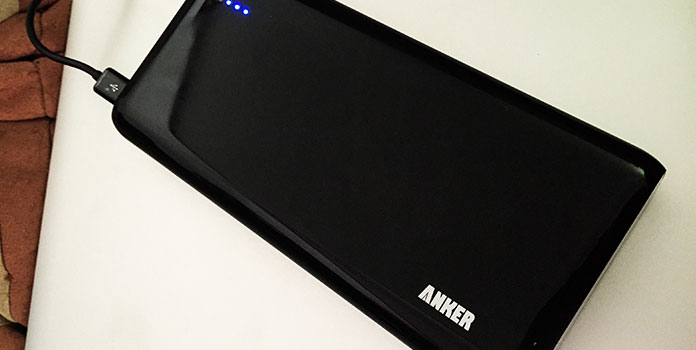

If you’re looking to store your solar energy to use after the sun goes down, you’re not just limited to the solar/battery combos like the one above. Instead, you can simply purchase a separate battery pack and just plug that into your solar charger. Once the sun goes down, just fold up your solar charger and plug your phone into the battery pack. They’re cheap, cost-effective, and very efficient.
Backup battery packs typically come in three sizes:
- Small ‘lipstick tube’ battery packs that store around 3,500 to 5,000 mAh of energy. These are usually good for a single phone charge, perfect if you’re out and about for a day and can recharge at home the next day. Prices usually fall around $15 to $20.
- Medium-sized packs are about the size of your smartphone and store around 10,000 mAh. They can recharge your phone 3 to 4 times and are great for couples or if you can’t recharge your battery every day. Expect a price tag around $20 to $30 for this size.
- Larger 25,000 mAh packs can charge phones 6-8 times before they need a recharge. Prices range around $40 to $50.
Solar chargers for your phone are an easy, inexpensive way to dip your toe into the world of solar energy. They’re portable, require no outlets or electricity grid, and charge up your electronics for free. Any of the above chargers will keep your devices topped up, so choose the one that sounds best for you and start running off the sun!
We hoped you found our list of the best solar phone chargers for 2018 useful! If you have any questions or thoughts on any of the chargers, ask away in the comments. Interested in going solar for real? Talk to a few installers and see what’s available for your home!

